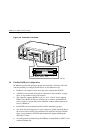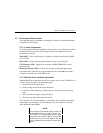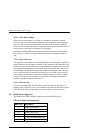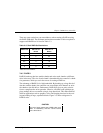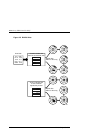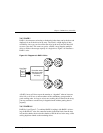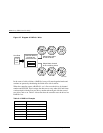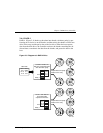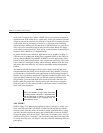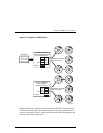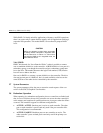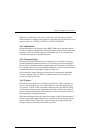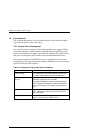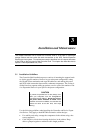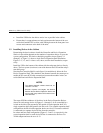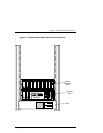
RAID Array 3000 Controller Shelf
2–14 EK–SMCPQ–UG. C01
In the event of a single drive failure, a RAID 4 array will continue to operate in
degraded mode. If the failed drive is a data drive, writes will continue as normal,
except no data will be written to the failed drive. Reads will reconstruct the data
on the failed drive by performing an exclusive-or operation on the remaining
data in the stripe and the parity for that stripe. If the failed drive is a parity drive,
writes will occur as normal except no parity will be written. Reads will simply
retrieve data from the data disks. There will be no deterioration in controller per-
formance while a RAID set is in degraded mode.
In general, RAID 4 is best suited for applications such as graphics, imaging, or
video that call for reading and writing large, sequential blocks of data. However,
you may find that RAID 4 is preferable to RAID 5 even for applications charac-
terized by many small I/O operations, such as transaction processing. This is due
to the controller’s intelligent caching, which efficiently handles small I/O reads
and writes, and to the relatively less complex algorithms needed to implement
RAID 4.
The benefits of RAID 4 disappear when you have many, small I/O operations
scattered randomly and widely across the disks in the array. RAID 4’s fixed par-
ity disk becomes a bottleneck in such applications, as the following example il-
lustrates. Let’s say the host instructs the controller to make two small writes. The
writes are widely scattered, involving two different stripes and different disk
drives. Ideally, you would like both writes to take place at the same time, but
RAID 4 makes this impossible, since the writes must take turns accessing the
fixed parity drive. For this reason, RAID 5 is the better choice for widely scat-
tered, small write operations.
CAUTION
RAID 4 can withstand a single failure and handle
I/O activity without interruption in degraded mode
until the failed drive is rebuilt. If a second drive
fails while the RAID set is in degraded mode, the
entire RAID set will fail.
2.6.5 RAID 5
RAID 5 (Figure 2–9) addresses the bottleneck issue for barrages of widely scat-
tered, small I/O operations. Like RAID 4, RAID 5 breaks up data into chunks,
calculates parity, and then writes the chunks in stripes to the disk drives, saving
one drive one each stripe for the parity data. Unlike RAID 4, however, RAID 5
changes the parity drive on each stripe. This means, for instance, that a write op-
eration involving drive 2 on stripe 1 can conceivably take place at the same time
as a write involving drive 3 on stripe 2, since they would be addressing different
parity drives.



